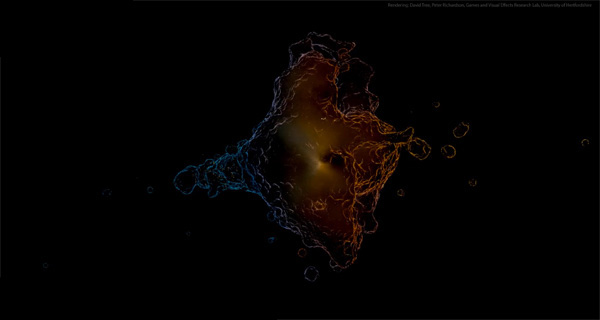Astronomers have directly observed a supernova-driven wind as it's rushing out of a galaxy and far into intergalactic space.
Most of a galaxy’s “normal” or baryonic mass is contained not in its stars but in gas that extends far beyond the galaxy itself. This gas is thought to fall inward over time, providing fuel for galactic star formation. But stars — or rather, the winds they produce as they’re born and as they die — are also thought to replenish that reservoir.

Jim Geach / David Tree / Peter Richardson / Univ. of Hertfordshire
For the first time, astronomers using the Keck Observatory’s Cosmic Web Imager have directly observed evidence of that replenishment. The KCWI took simultaneous images and spectra of a giant wind flowing out of a galaxy into the sparser medium that surrounds it. The galaxy, named Makani (“wind” in Hawaiian), has probably driven this tempest via bursts of star formation ignited during a merger with another galaxy. Makani is currently forming 100 to 200 solar masses of stars every year.
Galactic winds have been observed before, such as in the Teacup Galaxy, but not as far out. Makani’s galactic wind fills a region 260,000 by 330,000 light-years with hot (10,000 kelvin), ionized gas that’s enriched with elements heavier than hydrogen and helium.
A volume rendering of the data reveals Makani's structure:David Tree / Peter Richardson / Games and Visual Effects Research Lab / University of Hertfordshire
David Rupke and his colleagues report the data in the October 30th Nature.
 1
1
Comments
Bob
November 5, 2019 at 11:47 pm
Thanks for this important article about galactic winds.
You must be logged in to post a comment.
You must be logged in to post a comment.